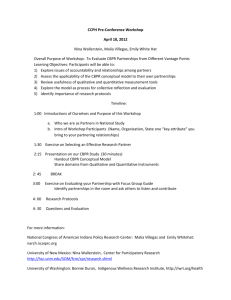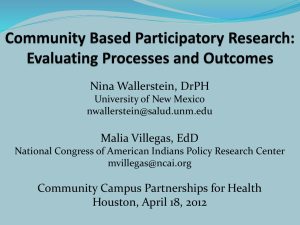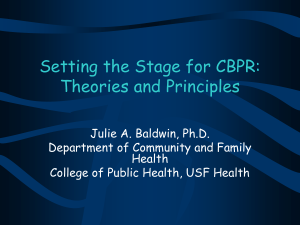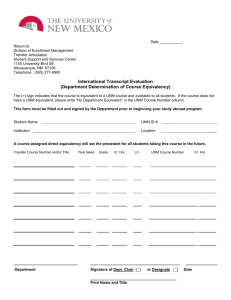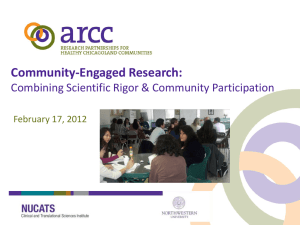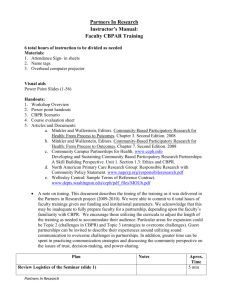Focus Group Guide for Partnership Collective Reflection and
advertisement
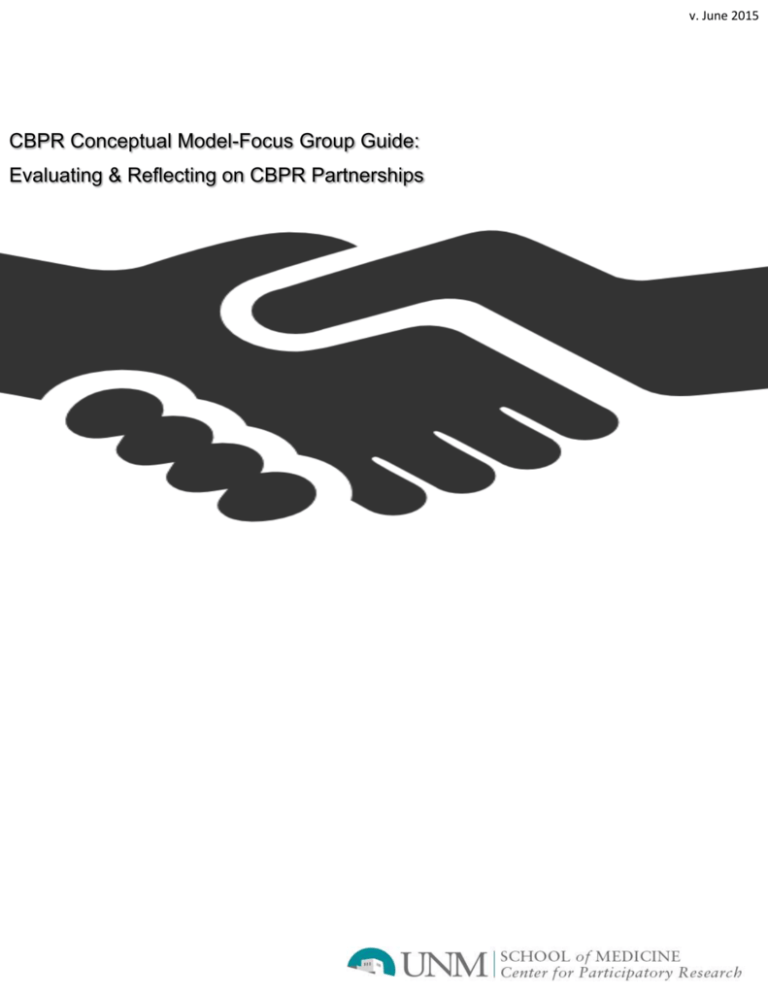
v. June 2015 CBPR Conceptual Model-Focus Group Guide: Evaluating & Reflecting on CBPR Partnerships CBPR Conceptual Model-Focus Group Guide: Evaluating & Reflecting on CBPR Partnerships This Focus Group Reflection and Evaluation Guide for Community Based Participatory Research (CBPR) and Community Engaged Research partnerships is for you to use as a tool to offer an opportunity for group reflection and evaluation of your partnerships. It was created as part of NIMHD (National Institute for Minority Health and Health Disparities, 20062009) pilot grant which allowed the University of New Mexico and University of Washington, in consultation with a National Advisory Board of academic and community CBPR experts (see end of document), to do an extensive literature search, look up reports, and consult journal articles about community-academic research partnerships, processes and CBPR outcomes. The pilot grant led to the NARCH-V (2009-2013) funded “Research for Improved Health: A National Study of CommunityAcademic Partnerships,” which was led by the National Congress of American Indians-Policy Research Center, with the University of New Mexico-Center for Participatory Research, and the University of Washington-Indigenous Wellness Research Institute. The National Institutes of Health funded project investigated promoters and barriers to CBPR in American Indian/Alaska Natives (AI/AN) communities and other underserved and minority communities; in order to improve health status and health equity. The CBPR Conceptual Model (see http://cpr.unm.edu/research-projects/cpbr-project/cbpr-model.html for full description and access to model and measurement tools) can be used by partnerships to examine their own internal processes, to reflect on the different outside conditions and contexts they face which may facilitate, or be barriers, to working together effectively. It also can be used as guide or tool to strategize the most promising practices to reach desired outcomes. This facilitator guide provides questions and a narrative for use with an accompanying slide show, which can be downloaded as handouts or shown as a presentation. This focus group can be conducted with community and academic partners. It may be useful to first present the whole model for discussion before launching into evaluation and reflection questions. Slide one contains the four dimensions with categories listed within each dimension and slide two contains the four basic dimensions in the model (presented as four ovals). Slides after these focus on each oval separately. Overview of Full Research Model Dimensions: Script: This focus group guide, based on the CBPR conceptual model, has questions on each dimension of the CBPR model. Before we talk about each dimension (represented in each oval), here is the full research model with the different constructs or categories within each dimension. [Show model and provide overview of the four dimensions] The dimensions of the CBPR model include: 1. Context or influences that come from outside the research partners and partnership. 2. Group dynamics within the partnership that influence the partnership, both what facilitates good interactions and what are the barriers to good partnering. These can be individual factors (what attitudes and beliefs both academic and community partners bring to the partnership), the relationship dynamics (how the research partners interact to achieve the overall goal) and the structures that support partnerships (what agreements and processes are in place to advance the partnership). 3. Intervention/Research Design or the actual research project. 4. Outcomes or what has been achieved by the project and research partnership. 1 Please visit UNM Center for Participatory Research http://cpr.unm.edu CBPR Conceptual Model-Focus Group Guide: Evaluating & Reflecting on CBPR Partnerships Slide 1: Complete CBPR Conceptual Model Overview of Four Dimensions: Script: Now let’s move into looking specifically at our partnership. For each dimension (context, group dynamics & equitable partnerships, intervention & research and outcomes), we will identify one or two categories or issues that are most important to us right now to discuss and reflect on. Here is the visual of all four dimensions. We’ll be covering each dimension one at a time. As you can see, each dimension shapes the other dimension. First the contextual factors shape the nature of the research partnership and can determine whether a partnership is initiated or how it is sustained over time. Next, group dynamics, consisting of three categories, individual, relationship, and structural, interacts with contextual factors to produce the intervention and its research design. Finally, CBPR intermediate system and capacity outcomes result directly from the intervention research to influence health, health disparities, and social justice, and can influence the way the partnership works in the future. 2 Please visit UNM Center for Participatory Research http://cpr.unm.edu CBPR Conceptual Model-Focus Group Guide: Evaluating & Reflecting on CBPR Partnerships Slide 2: CBPR Minimal Research Model Contexts: Script: Now let’s move into looking specifically at our partnership. There are several questions that we will answer for each of the four dimensions in thinking about our own partnership. For the theme of context, it’s important to recognize that all these contextual issues exist around us, which our partnerships may or may not be able to address. Some may impact our partnership more immediately or be more important for us to address. Let’s identify one or two categories or issues that are most important to us right now to reflect and think about, and which will allow us to evaluate which contexts have shaped our partnership processes. I. We want to start by asking, which of these six issues have impacted our partnership? (Which may not have impacted us?) II. Choose a category or issue to discuss more deeply. Which context issue have we had to tackle or which one would be important to discuss for our partnership at this time? III. For the chosen issue, the next probes can be used if answers to these questions have not already been discussed. The first two questions are more factual and may be answered more quickly. 1. What is our current approach to this context issue in our partnership? 2. What was our starting point in tackling this issue? 3 Please visit UNM Center for Participatory Research http://cpr.unm.edu CBPR Conceptual Model-Focus Group Guide: Evaluating & Reflecting on CBPR Partnerships 3. How well have we done so far? 4. Where would we like to be [choose one: in one year, five years, or another time span]? 5. What do we think are the best or promising practices to get there? Show slide 3: Contexts Group Dynamics and Equitable Partnerships: Script: For the theme of Group Dynamics, there are three categories in this area: individual dynamics or factors (attitudes and beliefs the individual brings to the partnership and the affect of these attitudes on group dynamics), relational dynamics or relationships (group interaction overall processes, such as decision-making, leadership, safety of community voice); and structural dynamics (structures, such as memoranda of agreement) that move partnerships forward. You may focus on each category separately, or on group dynamics as a whole. The box of characteristics provides details on each category (on slide 1), or the longer list of characteristics may be used for reference. 4 Please visit UNM Center for Participatory Research http://cpr.unm.edu CBPR Conceptual Model-Focus Group Guide: Evaluating & Reflecting on CBPR Partnerships I. II. 1. 2. 3. 4. 5. Which category or issue have we had to tackle or which would be important to discuss for our partnership at this time? Use the next probes if answers to these questions have not already been discussed. The first two questions are more factual and may be answered more quickly. What is our current approach to this group dynamics issue in our partnership? What was our starting point in tackling this issue? How well have we done so far? Where would we like to be [choose one: in one year, five years, or another time span]? What do we think are the best or promising practices to get there? Show slide 4: Group Dynamics Intervention/Research Design: Script: For the theme of Intervention/Research Design, use the following definitions or the longer list of characteristics as a reference. There are three different categories related to ensuring the intervention or research project matches the culture and context of the community. The category, Fits Local Cultural Knowledge/Norms and Practices means that the intervention is acceptable within community knowledge, norms, beliefs, or practices related to the health problem or program outcomes chosen, and may be more likely to be implemented and sustained over time. The category, Co-Learning/Partnership Synergy means that the research partnership will entail co-learning from the strengths and knowledge of both the academic and community participants. It means the group 5 Please visit UNM Center for Participatory Research http://cpr.unm.edu CBPR Conceptual Model-Focus Group Guide: Evaluating & Reflecting on CBPR Partnerships has the synergy to work together well to get the tasks done. The category, Appropriate Research Design, means that the community has had input to the research and the research is acceptable to the community. I. II. Which category or issue have we had to tackle or which would be important to discuss for our partnership at this time? Use the next probes if answers to these questions have not already been discussed. The first two questions are more factual and may be answered more quickly. 1. What’s our current approach to [developing, implementing, sustaining, or disseminating] the intervention? (The specific question needs to be based on what the partnership is doing at this time). How are we incorporating community or cultural knowledge? 2. What’s our approach to creating the research design? 3. How well have we done so far? 4. Where would we like to be [choose one: in one year, five years, or another time span]? 5. What do we think are the best or promising practices to get there? Show slide 5: Intervention/Research Outcomes: Script: For the theme of Outcomes, there are two categories of outcomes to think about: 1) intermediate outcomes, such as systems changes and capacity changes that may influence the ability of the partnership to be successful in the future. Examples might be new policies, programs, or stronger community organizations and collaboratives; it may mean that interventions are more likely to be 6 Please visit UNM Center for Participatory Research http://cpr.unm.edu CBPR Conceptual Model-Focus Group Guide: Evaluating & Reflecting on CBPR Partnerships sustained with community ownership, or there is greater connection to culture as a result of the intervention; and finally 2) health outcomes, or actual changes in health or conditions that improve health disparities. We’d like to start by asking if we think this partnership has the capacity to create system or capacity changes and improve health? The next questions should be asked first for intermediate systems and capacity outcomes; and secondly, for health outcomes. I. Which outcome(s) would you like to focus on now? II. Use the next question as probes: The first two questions are more factual and may be answered more quickly. 1. What was our starting point for this outcome? 2. How well have we done so far? 3. Where would we like to be [choose one: in one year, five years, or another time span]? 4. What do we think are the best or promising practices to get there? Show slide 6: Outcomes 7 Please visit UNM Center for Participatory Research http://cpr.unm.edu CBPR Conceptual Model-Focus Group Guide: Evaluating & Reflecting on CBPR Partnerships We have a few final questions: 1. How helpful has it been to use the model in evaluating your partnership and in reflecting about the issues in our partnership? Is this a process that would be helpful to do on an annual basis? 2. How could the model be changed to be more helpful in evaluating your partnerships? We believe that this model is dynamic and each partnership should feel free to adapt it and add constructs (or categories) within each oval dimension that may be appropriate for your own partnership to evaluate and track over time. 3. Finally, what is the most important lesson learned from your work with this partnership that might influence your decision to work with another partnership in the future? Thank you so much for the dialogue and evaluation of issues within the partnership. We hope this self-reflection and evaluation has been useful for your next steps. If you do create or re-create your own model and adapt the constructs/categories within each dimension to your own partnership, we’d love to hear from you. Send your adapted model and your insights to cpr.unm.edu. We’d love to post your model on our UNM Center for Participatory Research website to share with others if you are willing. Many thanks, Nina Wallerstein Producers of this Focus Group Guide: Julie Lucero, Lorenda Belone, Bonnie Duran, Greg Tafoya, Nina Wallerstein. Appreciation to oversight from the National Advisory Board of Think Tank of the CBPR Research and Evaluation Community of Practice: Margarita Alegria, Magdalena Avila, Elizabeth Baker, Beverly Becenti-Pigman, Charlotte Chung, Eugenia Eng, Shelley Frazier, Ella Greene-Morton, Lyndon Haviland, Jeffrey Henderson, Sarah Hicks, Barbara Israel, Loretta Jones, Michele Kelley, Paul Koegel, Laurie Lachance, Diane Martin, Marjorie Mau, Meredith Minkler, Naeema Muhammad, Lynn Palmanteer-Holder, Tassy Parker, Cynthia Pearson, Victoria Sanchez, Amy Schulz, Lauro Silva, Edison Trickett, Jesus Ramirez-Valles, Kenneth Wells, Earnestine Willis, and Kalvin White. Grant acknowledgements: Supplement to U26IHS300009A, National Center for Minority Health and Health Disparities in partnership with the Native American Research Centers for Health. CBPR NARCH V, 2009-2013, (U26IHS300293) Team Members: University of New Mexico (UNM): Magdalena Avila, Lorenda Belone, Lisa Herrera, Julie Lucero, Michael Muhammad, Emma Noyes, John Oetzel, Vanessa Simonds, Andrew Sussman, Greg Tafoya, Belinda Vicuna, Nina Wallerstein (UNM PI) University of Washington (UW): Bonnie Duran (UW PI), Leo Egashira, Cynthia R. Pearson, Maya Magarati, Elana Mainer, Chuan Zhou National Congress of American Indian Policy Research Center (NCAI PRC): Malia Villegas (Overall PI), Sara Hicks (first PI), Emily White Hat, Puneet Sahota Version June 2015 8 Please visit UNM Center for Participatory Research http://cpr.unm.edu
